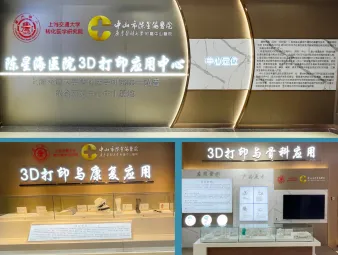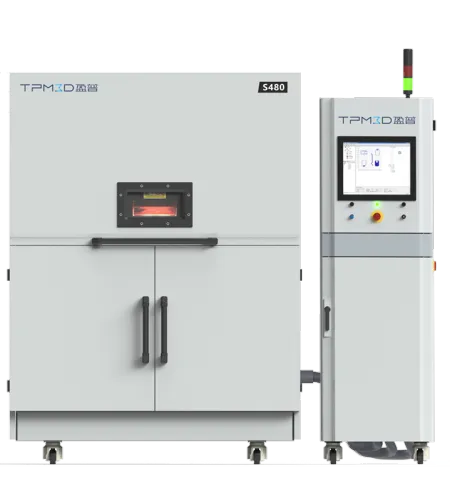TPM 3D Asia Advanced Materials Printing Center
TPM 3D Asia advanced materials printing center located in Jiangsu Province, cover the area with more than 1000 m2. The center consists of intelligent manufacturing 3D printing display platform, industrial and advanced materials intelligent printing center, medical sterile R&D experiment labs, and SLS post processing center and multimedia conference zone.
3D Printing Digital Medical Center
The center construction includes three phases, we can provide orthopedic insoles, orthopedic pillows, scoliosis braces, knee orthoses, application of surgical guides for head, pelvis, spine and knee joints and 3D printing of braces, as well as orthopaedic standardized implant products development.
Our research
TPM3D has successfully developed 10+ laser sintering additive manufacturing systems, and more than 10 kinds of polymer powder printing material for high-quality parts manufacturing, has more than 30 national patents as well.

We Have The Best Solutions for Your Business
TPM3D technical team has been engaged in industrial 3D printing business since 1999 and has become the industry brand with 20 years focusing on 3D printing service。
TPM3D has various customers at home and abroad from the fields of automobile, electrical appliances, electronics, medicals, cultural & creative, education, aerospace, such as Guangzhou Automobile, Dongfeng Motor, Gree Group, LG Electronics, TTI, Fohan Service Bureau, Tongji University, Southern University of Science and Technology, University of Texas at Austin, and Massey University Auckland.
Industrial SLS Printer Laser Sintering Process
The laser sintering process in an industrial SLS printer works as follows:
-
The operator designs the part or product using computer-aided design (CAD) software and converts the design into a file format that the printer can read.
-
The operator loads the material and the file into the printer and initiates the print process.
-
The printer deposits a thin layer of powdered material onto the build platform.
-
The printer uses a high-energy laser beam to selectively sinter the material according to the design. The laser beam scans over the powdered material, fusing the particles together to form a solid structure.
-
The build platform then lowers slightly and the process is repeated until the entire part or product is complete.
-
The finished object is then removed from the printer and may require post-processing, such as sanding or finishing, to achieve a smooth surface finish.
During the printing process, the powdered material is contained within a closed chamber, which helps to maintain a consistent build environment and prevent contamination. The laser beam is focused on a small spot on the powdered material, and the build platform moves to position the laser over the next area to be sintered. This process is repeated until the entire part or product is complete.
Advantages of Using Industrial SLS Printers
There are several advantages to using an industrial SLS printer over other 3D printing technologies, including:
-
Wide range of materials: SLS printers can use a variety of materials, including plastics, metals, and ceramics, allowing for the production of a wide range of parts and products.
-
High strength and durability: SLS-printed parts tend to be strong and durable due to the high-energy laser beam used to sinter the material.
-
Large build volumes: Industrial SLS printers often have large build volumes, allowing for the production of large parts or multiple parts at once.
-
Fast printing speeds: SLS printers can produce parts quickly, making them suitable for high-volume production.
-
Customization: SLS printers can be used to produce customized and personalized parts and products, such as personalized jewelry or customized sporting goods.
-
Reduced waste: SLS printers produce little to no waste, as the unused powdered material can be recycled and reused in future prints.
-
Reduced tooling costs: SLS printers can produce low-volume production tools, such as molds for injection molding or dies for stamping, at a lower cost than traditional manufacturing methods.
-
Reduced lead times: SLS printers can produce parts on-demand, reducing lead times and improving supply chain efficiency.
-
Increased design freedom: SLS printers allow for the production of complex and geometrically complex parts that may not be possible with traditional manufacturing methods. This can lead to the development of innovative new products and designs.
Industrial Sls Printer Application
Industrial SLS printers are used in a variety of applications, including:
-
Prototyping: SLS printers can quickly produce high-quality prototypes, allowing designers and engineers to test and iterate on their designs before moving to mass production.
-
Manufacturing: SLS printers can be used to produce end-use parts and products, such as automotive parts, aerospace components, and medical devices.
-
Tooling: SLS printers can produce low-volume production tools, such as molds for injection molding or dies for stamping, at a lower cost than traditional manufacturing methods.
-
Education and research: SLS printers are often used in educational and research settings to study and explore the capabilities of 3D printing technology.
-
Art and design: SLS printers can be used to create complex, sculptural works of art and design pieces.
-
Customization and personalization: SLS printers can be used to produce customized and personalized parts and products, such as personalized jewelry or customized sporting goods.
-
Repair and maintenance: SLS printers can be used to produce replacement parts for maintenance and repair, reducing downtime and improving efficiency.
Common Materials Used in Industrial SLS Printers
Industrial SLS printers can use a variety of materials, including plastics, metals, and ceramics. Common materials used in SLS printing include:
Nylon: Nylon is a strong, flexible, and durable material that is commonly used in SLS printing. It has a low melting point, making it well-suited for the SLS process.
Polystyrene: Polystyrene is a lightweight and rigid plastic that is commonly used in SLS printing. It is easy to process and has good dimensional stability.
Polycarbonate: Polycarbonate is a strong, transparent plastic that is commonly used in SLS printing. It has high impact strength and is resistant to chemicals and heat.
Aluminum: Aluminum is a lightweight and strong metal that can be used in SLS printing. It has good electrical and thermal conductivity and is resistant to corrosion.
Stainless steel: Stainless steel is a strong, corrosion-resistant metal that can be used in SLS printing. It has high wear resistance and is resistant to high temperatures.
Titanium: Titanium is a lightweight and strong metal that can be used in SLS printing. It has excellent corrosion resistance and is biocompatible, making it well-suited for medical applications.
Ceramics: Ceramics, such as alumina and zirconia, can be used in SLS printing to produce strong and durable parts with high temperature resistance and good wear resistance.
User Reviews
What users say about TPM 3D printing
Frequently Asked Question
Do you have any question?
Industrial SLS printers can use a variety of materials, including plastics, metals, and ceramics.
During the printing process, the powder material is contained in a closed chamber, which helps maintain a consistent build environment and prevents contamination. The laser beam is focused on a small spot on the powder material and the build platform moves to position the laser on the next area to be sintered. This process is repeated until the entire part or product is complete.
There are several advantages to using an industrial SLS printer over other 3D printing technologies, including:Wide range of materials、High strength and durability、Large build volumes、Fast printing speeds、Customization、Reduced waste、Reduced tooling costs、Reduced lead times、Increased design freedom.
The size of the build volume should be considered based on the needs and goals of the business or organization using the printer. Larger build volumes may be better for high-volume production, while smaller build volumes may be better for low-volume production or prototyping.

